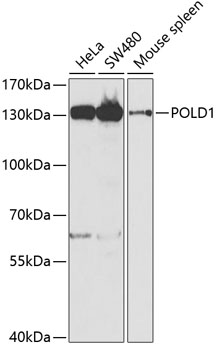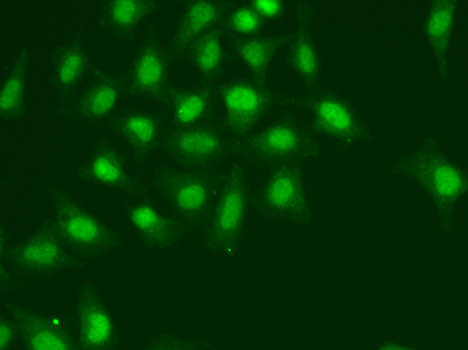-
Product Name
POLD1 Polyclonal Antibody
- Documents
-
Description
Polyclonal antibody to POLD1
-
Tested applications
WB, IHC, IF
-
Species reactivity
Human, Mouse, Rat
-
Alternative names
POLD1 antibody; CDC2 antibody; CRCS10 antibody; MDPL antibody; POLD antibody; DNA polymerase delta catalytic subunit antibody
-
Isotype
Rabbit IgG
-
Preparation
Antigen: Recombinant fusion protein containing a sequence corresponding to amino acids 808-1107 of human POLD1 (NP_002682.2).
-
Clonality
Polyclonal
-
Formulation
PBS with 0.02% sodium azide, 50% glycerol, pH7.3.
-
Storage instructions
Store at -20℃. Avoid freeze / thaw cycles.
-
Applications
WB 1:500 - 1:2000
IHC 1:50 - 1:200
IF 1:50 - 1:200 -
Validations

Western blot - POLD1 Polyclonal Antibody
Western blot analysis of extracts of various cell lines, using POLD1 antibody at 1:1000 dilution.Secondary antibody: HRP Goat Anti-Rabbit IgG (H+L) at 1:10000 dilution.Lysates/proteins: 25ug per lane.Blocking buffer: 3% nonfat dry milk in TBST.Detection: ECL Basic Kit .Exposure time: 90s.

Immunofluorescence - POLD1 Polyclonal Antibody
Immunofluorescence analysis of U2OS cells using POLD1 antibody . Blue: DAPI for nuclear staining.

Immunofluorescence - POLD1 Polyclonal Antibody
Immunofluorescence analysis of A549 cells using POLD1 antibody .

Immunofluorescence - POLD1 Polyclonal Antibody
Immunofluorescence analysis of U2OS cells using POLD1 antibody . Greenuff1agamma H2AX (phospho S139) used for DNA damage marker. Blue: DAPI for nuclear staining. Cells were treated by UV-A laser.
-
Background
As the catalytic component of the trimeric (Pol-delta3 complex) and tetrameric DNA polymerase delta complexes (Pol-delta4 complex), plays a crucial role in high fidelity genome replication, including in lagging strand synthesis, and repair. Exhibits both DNA polymerase and 3'- to 5'-exonuclease activities. Requires the presence of accessory proteins POLD2, POLD3 and POLD4 for full activity. Depending upon the absence (Pol-delta3) or the presence of POLD4 (Pol-delta4), displays differences in catalytic activity. Most notably, expresses higher proofreading activity in the context of Pol-delta3 compared with that of Pol-delta4. Although both Pol-delta3 and Pol-delta4 process Okazaki fragments in vitro, Pol-delta3 may be better suited to fulfill this task, exhibiting near-absence of strand displacement activity compared to Pol-delta4 and stalling on encounter with the 5'-blocking oligonucleotides. Pol-delta3 idling process may avoid the formation of a gap, while maintaining a nick that can be readily ligated. Along with DNA polymerase kappa, DNA polymerase delta carries out approximately half of nucleotide excision repair (NER) synthesis following UV irradiation. Under conditions of DNA replication stress, in the presence of POLD3 and POLD4, may catalyze the repair of broken replication forks through break-induced replication (BIR). Involved in the translesion synthesis (TLS) of templates carrying O6-methylguanine or abasic sites.
Related Products / Services
Please note: All products are "FOR RESEARCH USE ONLY AND ARE NOT INTENDED FOR DIAGNOSTIC OR THERAPEUTIC USE"
